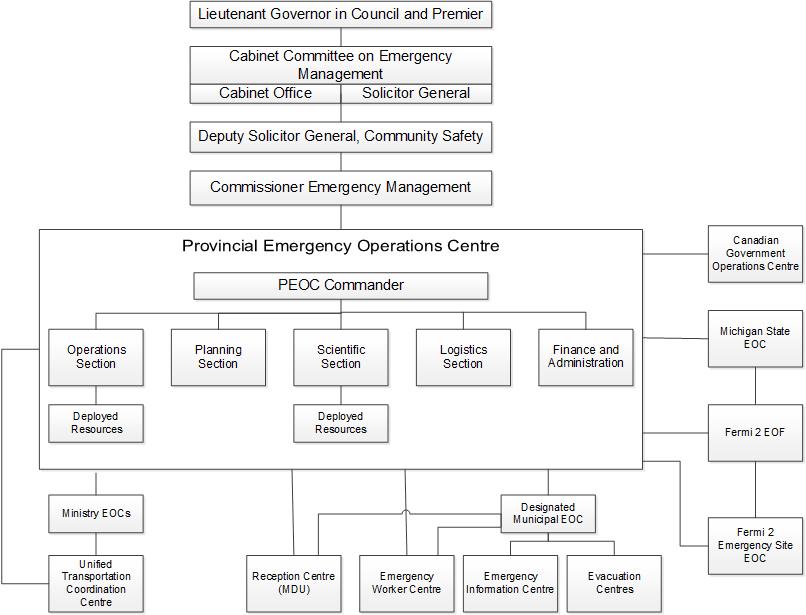Chapter 3: Emergency response organization and facilities
3.1 Emergency Response Organization
3.1.1 The provincial Emergency Response Organization (ERO) for managing a nuclear emergency at Fermi 2 Nuclear Power Plant is shown in Figure 3.1 and detailed in the PNERP Master Plan, Chapter 4.
3.1.2 Liaison arrangements
- To ensure liaison and coordination between different elements of the ERO, the following arrangements and agreements should be made:
- The Canadian Nuclear Safety Commission (CNSC) will establish liaison with the United States Nuclear Regulatory Commission (US NRC) on behalf of the provincial ERO.
- Each federal department and provincial ministry with a role in the emergency response to provide a representative to join the PEOC.
- Deployment of provincial staff to the State of Michigan Emergency Operations Centre if operationally practical, or virtually.
- Deployment of provincial staff to Municipal Emergency Operations Centres.
- Health Canada will establish liaison with the US Department of Energy (US DOE).
- Role of deployed provincial staff
- Maintain close liaison with representatives in the municipal emergency operations centres.
- Transmit all relevant information to the PEOC and appropriate provincial agencies.
- Provide relevant information from the PEOC on developments in Ontario to the applicable emergency operations centre.
- Deployed provincial staff may include any of the following:
- OFMEM field officers
- Scientific Section staff
- Emergency information officers
- Others as appropriate to the situation.
3.1.3 Arrangement with Michigan State Police and DTE Energy
- Ontario shall establish a Letter of Agreement for Notification and Information Sharing with Michigan State Police and DTE Energy (Fermi 2 operator).
- This agreement shall include the following items:
- Notification arrangements indicating initial notification point of contact.
- Exchange of information from Michigan and DTE Energy to the PEOC, both during an emergency and during the preparedness phase.
- Agreement to receive, accommodate and provide facilities to provincial staff deployed to other jurisdictions.
- Coordination of emergency information during an emergency.
3.1.4 Unified Transportation Coordination Centre
A Unified Transportation Coordination Centre shall be set up and staffed for a Fermi 2 emergency to implement the Unified Transportation Management Plan upon notification of either a partial or full activation response by the province. MTO and the OPP are co-responsible for the planning, activation and operations of the Unified Transportation Coordination Centre
3.1.5 Provincial ministry offices
The following regional, district and area offices of provincial ministries shall be prepared to respond to the emergency and provide the necessary assistance to the designated municipalities, as required by the PNERP Master Plan, Annex I and detailed in municipal plans or, as directed by their respective ministries:
- Ministry of Agriculture, Food and Rural Affairs; Ridgetown Resource Centre
- Ministry of the Solicitor General, OPP; Essex County Detachment, Chatham Detachment and Western Region Headquarters
- Ministry of the Environment, Conservation and Parks; Windsor Area Office, Sarnia District Office, Southwestern Regional Office and Wheatley Provincial Park
- MOH; Windsor Central Ambulance Communications Centre
- Ministry of Labour, Training and Skills Development; Windsor Area Office and London Area Office
- Ministry of Municipal Affairs and Housing; Western Region Municipal Services Office
- Ministry of Northern Development, Mines, Natural Resources and Forestry; Chatham Area Office (Aylmer District)
- MTO; Western Region
3.1.6 Designated and host municipality organization
Emergency plans for the designated and host municipalities (i.e., the Town of Amherstburg, Town of Essex and the City of Windsor) shall describe their municipal emergency response organizations and how their plans are activated.
3.2 Contingency provisions
3.2.1 The PEOC commander issues operational directives to the emergency management and response organization through the centres in the structure below (see Figure 3.1). However, if for any reason, any of these centres is not functioning or is not responsive, the PEOC commander may issue operational directives directly to any other element of the emergency management and response organization. The Chief Medical Officer of Health has the decision-making authority regarding iodine thyroid blocking.
3.3 Municipal emergency facilities
- Designated and host municipalities' nuclear emergency plans shall identify the location of the following emergency facilities and shall include provisions for their selection, staffing and resourcing:
- Municipal Emergency Operation Centre
- Reception Centres. Reception Centres should also be able to accommodate a monitoring and decontamination unit.
- Evacuation Centres (host municipalities)
- Emergency Worker Centres. These locations shall also be able to accommodate a monitoring and decontamination unit as well as a command post for environmental monitoring operations of the Environmental Radiation and Assurance Monitoring Group. Both of these components of the Emergency Worker Centres will be coordinated through the Province.
- Emergency Information Centre
- Municipal nuclear emergency plans shall also identify the location of alternate Municipal emergency facilities outside the CPZ.
- OFMEM shall coordinate arrangements for the provision of equipment and trained staff to perform monitoring and decontamination activities at Reception Centres and Emergency Workers Centres, as outlined in PNERP Master Plan, Annex B Section 4.5. These arrangements shall be coordinated with the designated municipalities.
3.4 Telecommunications
3.4.1 All stakeholder emergency plans shall describe how their emergency centres and facilities are linked via primary and backup communication systems which enable email and transfer of emergency information.
3.4.2 The Fermi 2 operator should establish primary and backup communications between its Emergency Operations Facility (EOF) and the PEOC.
3.4.3 All organizations and agencies in Ontario involved in responding to a Fermi 2 nuclear emergency shall ensure the availability of backup telecommunications systems.

Footnotes
- footnote[5] Back to paragraph Refer to the PNERP Master Plan Chapter 4 for more information.